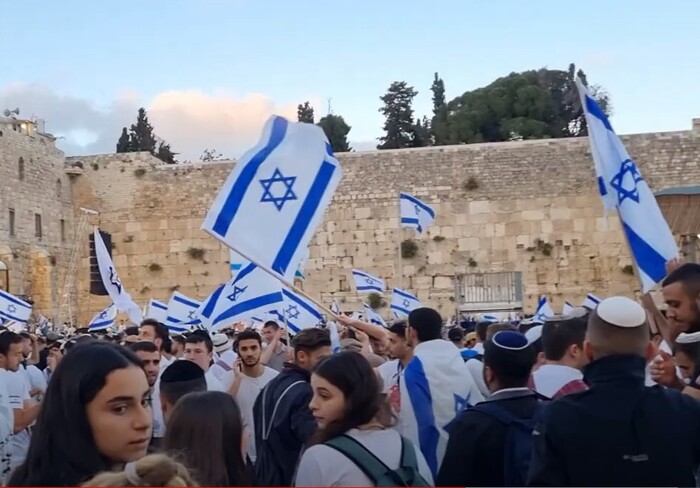In 2018-19, the Guardian routinely described the weekly Hamas-organised violent Palestinian riots on Israel’s border benignly as “protests“, and the rioters as “protesters“. Readers typically had to scroll down many paragraphs before the article even alluded to the violence that the IDF was responding to.

Reporting on periodic unprovoked Palestinian attacks on police at the Temple Mount over the years, the Guardian has routinely described those violent Palestinian Muslims – who sometimes desecrated the holy site by launching attacks from inside the mosque – as “worshippers”. Similarly, readers often had to scroll down many paragraphs before getting any sense that that “worshippers” had engaged in violence.

But, as we’ve documented thousands of times, when it comes to Israel, coverage of events where a small number of Israeli Jews engage in violent or hateful behavior, is far, far different. Here’s their headline in a Guardian article by Ben Lynfield and Quique Kierszenbaum about the estimated 50,000 Israelis celebrating Jerusalem Day (Yom Yerushalayim) on Thursday.

Most of the article – ten out of fourteen paragraphs – focuses on the relatively few incidents of violence and racism.
The article opens, thusly:
Thousands of Israeli nationalists, some of them chanting racist slogans, have paraded through Jerusalem’s Old City in an annual celebratory day for Israelis that became one of humiliation for Palestinians living under occupation.
The marchers, mostly male Orthodox teens and young men, were celebrating Israel’s capture of East Jerusalem in 1967. The crowd waved blue and white Israeli flags and chanted slogans such as “Death to Arabs” and “We will burn your village”.
How many of the the “nationalists” chanted racist slogans? According to Times of Israel’s reporters who covered the event, there were “several dozen instances of violence and harassment by Jewish participants”, mostly at the Damascus Gate of the Old City and inside the Muslim Quarter. Though, of course, even one such instance is one too many, Guardian readers were given the false impression that such disgraceful conduct was the norm, rather than the exception. The overwhelming majority of Jews celebrating that day were peaceful.
As far as what the Guardian describes as a day of “humiliation for Palestinians living under occupation”, that presumably refers to Palestinian residents of east Jerusalem, who have most of the rights that Israeli citizens have, and majority of whom, if given the choice, would not want to live under Palestinian sovereignty if a Palestinian state is created. Though the area of Israel’s capital known as ‘east Jerusalem’ is often described as “occupied east Jerusalem” by media outlets, the Palestinian residents there are not living under “occupation” in the sense that word is normally used in reference to West Bank Palestinians.
The Guardian narrative of ‘humiliated’ Palestinian Muslims is even more misleading in light of their omission on why Israelis celebrate the the 7th of June, 1967, when, during the Six Day War, in which Arab armies attempted but failed to destroy Israel, IDF paratroopers captured east Jerusalem from Jordan: because, during Amman’s occupation of that part of the city, from 1949-1967, the entire Jewish population – who were expelled during the 1948-49 war – was barred from east Jerusalem, including the Western Wall and Temple Mount – Judaism’s holiest site.
As our CAMERA colleague wrote about Jordan’s actions after the 48-49 war:
Upon its capture by the Arab Legion, the Jewish Quarter of the Old City was destroyed and its residents expelled. Fifty-eight synagogues—some hundreds of years old—were destroyed, their contents looted and desecrated. Some Jewish religious sites were turned into chicken coops or animal stalls. The Jewish cemetery on the Mount of Olives, where Jews had been burying their dead for over 2500 years, was ransacked; graves were desecrated; thousands of tombstones were smashed and used as building material, paving stones or for latrines in Arab Legion army camps. The Intercontinental Hotel was built on top of the cemetery and graves were demolished to make way for a highway to the hotel. The Western Wall became a slum area.
Here’s a brief thread providing more context:
6. #JerusalemDay
And on that day in 1948, Jews were banished from Jerusalem's Old City and their holy sites.
A Jordanian Legionnaire and policeman were posted at the Western Wall to maintain the Judenrein policy that was enforced for 19 years. pic.twitter.com/6QQQZKDKwP— Lenny Ben-David (@lennybendavid) May 18, 2023
The joyous celebrations by Israelis on Yom Yerushalyim – which the BBC’s Jeremy Bowen derisively referred to on Twitter as “ugly triumphalism” – represent the natural expression of a people who possess a 3,000 year spiritual and historical connection to Jerusalem. As Israeli journalist Haviv Retig Gur observed, “it is hard to imagine a more perfect rendering” of the Biblical prophets’ belief that the ultimate redemption “comes only after great suffering and tribulation” than the fact that a “mere 22 years that separate Auschwitz from the paratroopers at the Wall, the return to the heavy stones of mother Jerusalem, to the beating heart of Jewish history and geography”.




